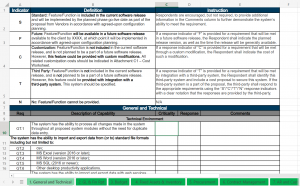As organizations grow, one truth remains constant: technology must evolve in tandem with expansion. This reality is especially true for human resources teams who often find themselves at a juncture where their technology must undergo a transformation. The role of HR continues to evolve, from tracking diversity metrics to sculpting policies that accommodate both remote work and in-office collaboration. That’s why HR departments must ensure that their technology and workflows remain aligned with business goals.
Human Capital Management (HCM) technology not only improves the experience of HR teams but also the overall employee journey. From the moment a new hire joins your organization, they will interact with the HCM software and use it almost every day. Having a positive experience with HCM technology can also help improve retention. That’s why investing in the right technology for your organization is important.
However, before HR teams dive headfirst into a project or embark on a Request for Proposal (RFP), they must examine their own HR operational needs. Our exploration delves into the pivotal steps that HR teams must navigate before investing in HCM technology.
1. Evaluate your existing system.
Embarking on the path to a successful HCM technology upgrade begins with a comprehensive evaluation of your current system. As part of your assessment, list out the system functionalities that you both like and don’t like. It’s very easy to fall into thinking everything needs to change, but we recommend focusing solely on essential components that require a transformation, along with features you want to preserve. This strategic discernment not only streamlines your efforts but also acts as a compass guiding you toward a more efficient and cost-effective transformation.
2. Review your current business processes.
After reviewing your current system, the next step is to review your current business processes. Compare your business processes with best practices, and decide what works, what could be enhanced with the new technology, and what could be eliminated completely. For example, could you eliminate forms you currently use to authorize changes to employee records? Perhaps this could be a workflow with manager approval.
By examining what processes are required and what can be eliminated (or improved), you will make the most of system functionality while making the implementation process more efficient.
3. Create a list of essential features.
Prioritize clarifying your requirements before delving into research and exploration of HCM technology systems. Rather than seeking a system to match your needs, begin by outlining your needs. Allow each member of the team to create their own list and then come together to rank each item and categorize them into “non-negotiable must-haves” to “good to have” to “maybe another time”. This process will help get teams on the same page and ensure that the project doesn’t go over budget.
It’s crucial to ensure a clear understanding of your reporting and analytical requirements. While modern systems offer impressive features, the insights you gain from reports hinge on the system’s initial configuration.
Also, decide as a team which features of the system are needed first and which features can wait. For example, perhaps a new payroll system is more important than a mobile app for employees to access. You can save time and money on the project if your team decides that one feature must be rolled out by a certain date, and then the vendor can rollout the next set of features a few months later. If you plan effectively, one set of features could be rolled out in one fiscal year and then a new set could be rolled out in the new fiscal year, thus spreading costs over two annual budgets.
4. Get buy-in and support from executives.
Gather your research and your best presentation skills to present the idea of switching over to new HCM technology. Discuss pain points that the HR team is facing, how it affects the employee experience and how it affects the organization overall. Know what your organization’s goals are, and shape why switching to a new system will help meet these goals. Without executives on board with the switch, the project could be delayed, and the budget be severely underwhelming.
5. Plan key components of the project.
Here are some questions to answer before the RFP process:
- Who will be the project manager? This person will be the main liaison between the vendor and the team.
- Who will be on the project team? Make sure the team is balanced with members who know the problems with the current system and who can represent the department and organization well. Don’t make the team too large. For example, you need HR and Payroll subject matter experts, but you do not need the entire HR and Payroll team.
- What is the timeframe, deadline, and other important dates? Know your team’s availability, vacation days and how that would affect the timeframe of the project and then decide on a drop-dead date.
- What is the plan to ensure business is still running during the project and implementation stages? Determine who can cover the roles of the project team while they are working with the vendor, especially critical project days.
 Once all these steps are completed, you are ready to start on the RFP process. To make this phase easier, download OnActuate’s government RFP template to guide you through writing an RFP.
Once all these steps are completed, you are ready to start on the RFP process. To make this phase easier, download OnActuate’s government RFP template to guide you through writing an RFP.
Understanding that investing in HCM technology is a significant step forward, you are likely wondering about the array of options available to you. Here are two of the top choices in the market:
- Award-winning Dayforce platform, from Ceridian
- Data-driven, people-centric Microsoft Dynamics 365 Human Resources
No matter if you’re just starting on the steps listed above, about to publish your RFP, need some help convincing your executive team, or already in the process of contacting vendors, OnActuate has the expertise to help. Schedule a call with our team of experts to get started.
Explore more resources to help you dive deeper into the realm of HCM innovation and revolutionize your HR practices.
 |
 |
 |
| Top 3 RFP Pitfalls and How to Avoid Them | User Experience: The Three E’s in Choosing the Right Modern HR Technology |
Embracing AI in Human Resources: Revolutionizing HCM Technology |







